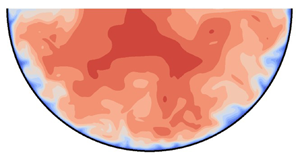Article contents
Numerical investigation of semifilled-pipe flow
Published online by Cambridge University Press: 06 December 2021
Abstract

This study describes turbulent flow in a semifilled pipe with a focus on its secondary currents. To the authors’ knowledge, we provide the first highly resolved data-set for semifilled-pipe flow using direct numerical simulation. The flow parameters range from  $Re_\tau =115$, just maintaining turbulence, to moderate turbulent flow at
$Re_\tau =115$, just maintaining turbulence, to moderate turbulent flow at  $Re_\tau =460$. Some of the main flow characteristics are in line with previously published results from experiments, such as the velocity-dip phenomenon, the main secondary flow and the qualitative distribution of the Reynolds stresses in the core of the flow. We observe some flow phenomena which have not yet been reported in the literature so far for this type of flow. Among those is the inner secondary cell in the mixed corner between the free surface and the pipe's wall, which plays a major role in the distribution of the wall shear stress along the perimeter. We observe that the position and extension of the inner vortex scale with the wall shear stress and those of the outer vortex scale with outer variables. For the first time, we present and discuss distributions of the complete Reynolds stress tensor and its anisotropy which gives rise to the generation of mean streamwise vorticity in a small region in the mixed corners of the pipe. Mean secondary kinetic energy, however, is generated at the free surface around the stagnation point between the inner and outer vortices. This generation mechanism is in line with a vortex dynamics mechanism proposed in the literature.
$Re_\tau =460$. Some of the main flow characteristics are in line with previously published results from experiments, such as the velocity-dip phenomenon, the main secondary flow and the qualitative distribution of the Reynolds stresses in the core of the flow. We observe some flow phenomena which have not yet been reported in the literature so far for this type of flow. Among those is the inner secondary cell in the mixed corner between the free surface and the pipe's wall, which plays a major role in the distribution of the wall shear stress along the perimeter. We observe that the position and extension of the inner vortex scale with the wall shear stress and those of the outer vortex scale with outer variables. For the first time, we present and discuss distributions of the complete Reynolds stress tensor and its anisotropy which gives rise to the generation of mean streamwise vorticity in a small region in the mixed corners of the pipe. Mean secondary kinetic energy, however, is generated at the free surface around the stagnation point between the inner and outer vortices. This generation mechanism is in line with a vortex dynamics mechanism proposed in the literature.
- Type
- JFM Papers
- Information
- Copyright
- © The Author(s), 2021. Published by Cambridge University Press
References
REFERENCES
- 7
- Cited by





